| Published
on 23
Apr
2018 |
All rights reserved.
|
|
|
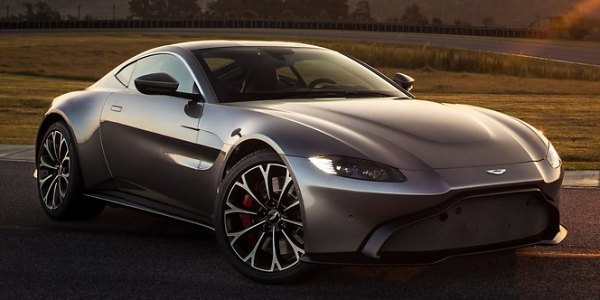
|
|
The
first new Vantage in 12 years gets significantly more performance and
sophistication.
|
|
Having soldiered on for 12
years, Aston Martin V8 Vantage was finally retired last year. Some
25,000 cars were sold during its long lifecycle, eclipsing DB9 and DB7
as the best selling model in company history. The new Vantage – note
that it loses “V8” in its name – is again the company's entry-level
sports car. However, it differs from its predecessor in many ways.
First
of all, this car gets considerably larger. Its 4465mm overall length is
85mm longer than before, if still shorter than a Porsche 911. More
crucially, its body width is stretched by 77mm to 1942mm, which exceeds
911 GTS by as much as 90mm! Meanwhile, its wheelbase is lengthened by
104mm to 2704mm, which should improve
ride and directional stability. Predictably, the larger car is also
more expensive.
In UK, it starts from £121,000, a sizeable increase
from the previous £93,000, although it still undercuts DB11 V8 by
£24,000. In return, you get significantly more performance and
sophistication.
The Vantage has taken a new styling direction, too. Design boss Marek
Reichman determined to end the Russian doll approach of family styling.
He deliberately gave the Vantage a more muscular and aggressive look
than the DB11. The front end has a huge mesh mouth stretched right down
to the front splitter. It looks like a shaver head and quite odd for a
road car, but Reichman argues that it is driven by function, saving
excessive decorations and cutting inertia from the nose. Equally a bit
strange is the contoured clamshell bonnet, which is necessary to
accommodate the taller Mercedes “hot-Vee” V8 while leaving enough
clearance to comply with pedestrian safety law. As the front wheels
have been enlarged and pushed forward, leaving little space at the
front overhang, the Vantage has to adopt very small LED headlamps.
Unfortunately, those headlamps look rather characterless, blame to the
lack of stylish patterns and graphics.
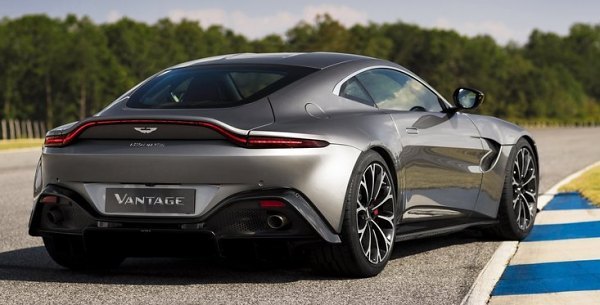
|
|
No
more Russian-doll styling. The Vantage is more muscular and aggressive
than DB11.
|
|
On the plus side, the rear styling should be universally
acclaimed, especially its stylish LED stripe light and aggressive
diffusers, which generate 77kg of downforce at top speed. Side view of
the car is more muscular and less sexy than the DB11, thanks to the
shorter wheelbase and a convex shoulder line. Also, you will notice
that the wheels are pushed further outside so to achieve a sportier
appearance. Despite lighter kerb weight, the 20-inch wheels and Pirelli
P-Zero tires are the same
size as its larger sibling's.
Like DB11, the Vantage is built on the new generation VH platform. The
chassis is still made of bonded aluminum, but it has increased the use
of pressed and cast aluminum parts instead of extrusions in order to
save space. A carbon-fiber driveshaft runs inside an aluminum torque
tube. The body panels are made of aluminum or composites. 30 percent of
the structural parts, mainly at the center, are shared with DB11, while
the remaining 70 percent are bespoke. The body in white is 20kg lighter
than the old car’s, while torsional rigidity is boosted by 30 percent
to 35,000 Nm per degree.
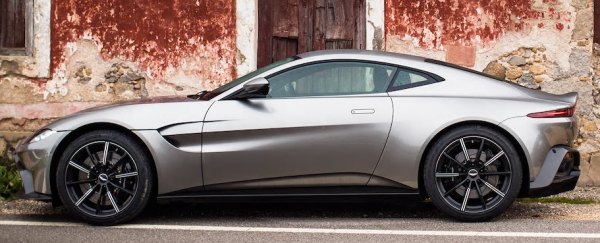
|
|
New
VH platform employs more pressed and cast aluminum.
|
|
Suspension is implemented by forged double-wishbones up front and
multi-link axle at the rear like its sister car, but its rear subframe
is rigidly mounted on the main chassis without bushings for the sharp
response and precision demanded by a sports car. The AMG V8 motor is
positioned as far back as possible, while the ZF 8-speed automatic
transmission is once again located at the rear axle, a trademark layout
of modern Astons. That said, its front-to-rear weight distribution is
barely 50:50. For your reference, both the DB11 V8 and the old V8
Vantage achieved 49:51.
Some might feel disappointed that the Aston no longer employs its
homegrown engine. The last 4.7-liter V8 was originated from Jaguar. It
might be down on power, but it was full of character. Fortunately,
AMG’s 4-liter V8 is a characterful engine, too. In fact, I can’t think
of any mass production V8 better suited to the duty of Vantage. It is
not just powerful and torquey but also produces a mighty exhaust note
in various applications of AMG. On the Aston, the V8 is given a
bespoke, slimmer wet sump (in contrast to the dry sump of AMG GT) as
well as bespoke intake and exhaust to produce a unique noise. Its
maximum output is 510hp at 6000 rpm, less than the hotter versions of
AMG GT – it goes without saying Mercedes saves the best for itself –
but 80 horsepower up from the old naturally aspirated V8. Moreover, its
torque curve peaks at 505 lbft from 2000 to 5000 rpm, compared with 361
lbft at 5000 rpm of its predecessor. This means performance is lifted
to a different league. 0-60 mph now takes only 3.5 seconds instead of
4.6, while top speed is lifted to 195 mph. It is also noticeably faster
than the DB11 V8 (187 mph and 3.9 sec), thanks to the 130kg lighter
kerb weight.
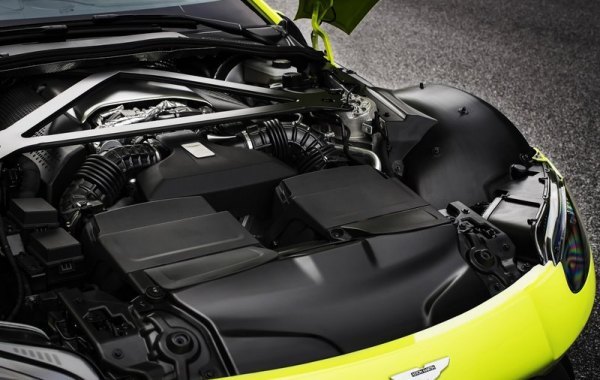
|
|
I
can't think of any mass production V8 better suited to the duty of
Vantage...
|
|
The Vantage employs the same ZF 8-speed automatic
transmission as DB11, but its final drive ratio is increased from 2.7:1
to 2.9:1 in order to quicken acceleration and deliver a more urgent
feel, admittedly at the price of cruising refinement. Power goes to the
rear axle through an electronic LSD, a first for Aston – it must be
noted that Ferrari, Porsche, Audi, BMW M and Mercedes-AMG have been
using this technology for long. Aston is late to the party, but late is
better than never. With active LSD, hopefully its at-the-limit handling
could be
significantly improved. Adaptive dampers, torque vectoring and electric
power steering are also new features to the Vantage. The
brakes use ventilated cast-iron discs of 400mm or 360mm, clamped with
6-piston or 4-piston calipers. Ceramic brakes are optional.
Inside the cabin, Marek Reichman trades conventional cockpit design
with something funkier – probably too funky for a luxury sports car I
think. It looks cheaper and busier than the interior of DB11. Materials
are generally expensive, with fine leather, Alcantara and real
aluminum, but some controls, like air-con, audio and gearshift paddles,
feel cheap for a car at this price. The center console is overcrowded
with buttons. Reichman deliberately uses many old-school rotary knobs
and toggle switches but the result is over-complication and a nightmare
of ergonomics. Fortunately, the Mercedes-sourced touchscreen
infotainment system and mouse-like COMAND controller save the game. As
before, the Vantage is strictly a 2-seater. This leaves a quite
generous 350-liter boot behind the seats.
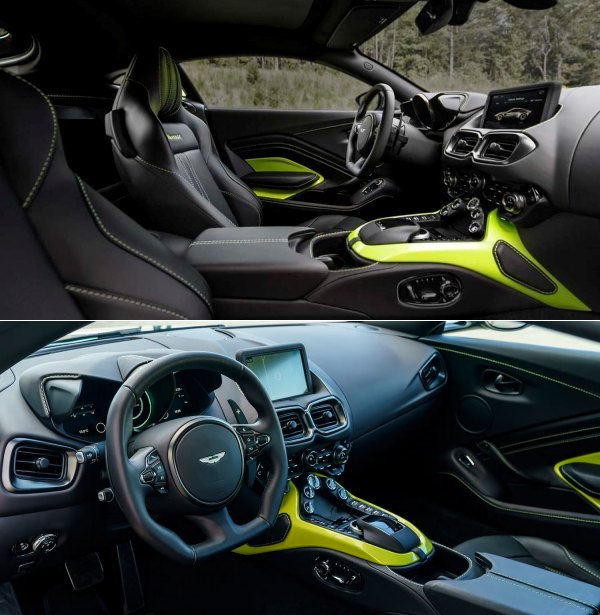
|
|
Materials
are generally expensive, but some controls feel cheap...
|
|
Once you get into the cockpit, you will find the driving position
spot-on and the low-mounted seat supportive. The high waistline makes
it feel exotic, but outward visibility is much poorer than Porsche,
especially as you cannot see both ends of the car. On the steering
wheel there are 2 mode buttons, one controls the adaptive damping and
another the rest of the driving characteristics (engine, gearbox,
stability control etc.). Each of them offers 3 modes: Sport, Sport+ and
Track. Compared with DB11, it loses GT mode and gains Track mode for
obvious reasons.
Start the car in Sport mode, the engine comes into life with a deep
rumble. The V8 is very potent, unquestionably. It feels punchy at
whatever rpm. It has virtually no turbo lag to overcome, responding to
throttle quickly and revving smoothly. Its exhaust note is not quite as
loud or as raucous as AMG, but at higher revs it morphs into a
high-pitched growl not unlike that of the old naturally aspirated V8.
The acoustic engineers have done a great job to make it feel more Aston
than AMG.
While the dual-clutch gearboxes of AMG GT or Porsche PDK are a tad
sharper, the ZF automatic is so well calibrated that you won’t feel
short-changed. It responds quickly enough to your input and always
shifts seamlessly. It suits the character of Aston.
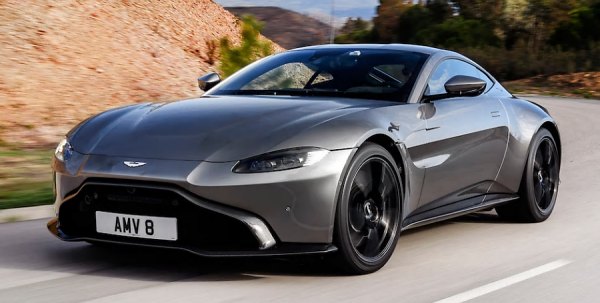
|
|
Dynamically
it is a huge leap from the V8 Vantage...
|
|
However, what really surprises is the chassis. It has the
outstanding balance of the outgoing Vantage GT8 but added more grip
and
poise. Its steering is sharp but not nervous, although it loses the
tactile feedback of the old car (which employed hydraulic steering,
sigh!). The nose follows strictly to your commands as the front tires
generate terrific grip. Thankfully, the ride is not rock-hard. It is
inevitably stiffer than DB11, but still useable on back roads as
long as you leave the electronic dampers in the softest mode. Only the
excessive road noise
– blame to the rigidly mounted rear subframe – robs it the chance as a
long-distance cruiser. Push it harder on a twisty road, the Vantage is
less incisive than a 911 owing to its extra weight and width.
Nevertheless, on a wider track its handling is amazing. Ex-Lotus road
test engineer Matt Becker tuned it to be so docile at the limit. Push
it beyond the threshold and it will understeer progressively. You can
use a quick counter-steer and prod the throttle to adjust its angle of
attack in corner. The beautiful balance and the active differential
works so well to make it immensely fun to drive. It is fast on a
circuit, too.
The new Vantage feels significantly sportier and more entertaining than
the DB11. It is also a huge leap from the V8 Vantage. The best Aston
yet? In terms of driver appeal, yes, definitely. The best in class? No,
sorry. It is considerably more expensive than a 911 GTS (its closest
rival in essence) but the Porsche feels lighter, nimbler and more
comfortable as well. A 911 GT3 is even more thrilling to drive. You
might consider the base 911 Turbo, AMG GT C and Audi R8 V10 as its
rivals as well. However, the Aston feels different, and it
is competitive enough in most areas to attract buyers. If
it lives long enough, it might just rewrite the sales record of its
predecessor.
|
Verdict:     |
Published
on 10
Feb 2020
|
All rights reserved.
|
|
Vantage AMR
|
|
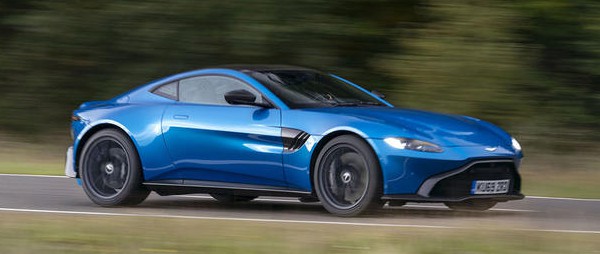
|
|
AMR
gets less power and slower acceleration. Can the driving experience
make up for the loss?
|
|
The Aston Martin Racing
version of Vantage differs from the standard car mainly in
transmission. Instead of the ZF 8-speed automatic, it employs a 7-speed
manual built by Graziano. Yes, that is exactly the same gearbox
available to the last generation V12 Vantage S later in its life,
including the same ratios. The intent is to enhance driver engagement,
even at the price of performance – 0-60 mph takes 3.9 seconds, 0.4 more
than the automatic version. This is not purely down to the shift time
or launch control, but the AMG V8 engine has its maximum torque limited
to 461 lbft (down from 505) to avoid damaging the gearbox.
Losing the automatic gearbox also triggers the change of differential.
While the ZF auto links to an active differential, the 7-speed manual
couples to a mechanical LSD. Is it a deliberate change? I don’t know.
Modern electronic differentials usually have their control system
linked to the transmission. Perhaps it would be too expensive to
redevelop the e-diff to suit the manual gearbox. Anyway, the
combination of manual gearbox and mechanical LSD saves 70 kg. This
sounds good, but it alters the weight distribution (from 49:51 to less
favourable 51:49 as the Vantage places its gearbox at the rear axle).
As a result, Aston needs to retune its suspension. The rear springs get
softer, the anti-roll bars get stiffer, and all dampers are retuned, so
it makes sure the AMR doesn’t understeer more than the standard car.
Another 25kg is shaved by fitting carbon-ceramic brakes and lightweight
forged alloy wheels as standard. Predictably, the AMR costs more. At
£150,000, it is more expensive than 911 Turbo S, Audi R8 V10
Plus, AMG GT C and McLaren 570S, though by not much. Compared to these
wonderful machines, the Aston gets less power and significantly slower
acceleration. Can the driving experience make up for the loss?
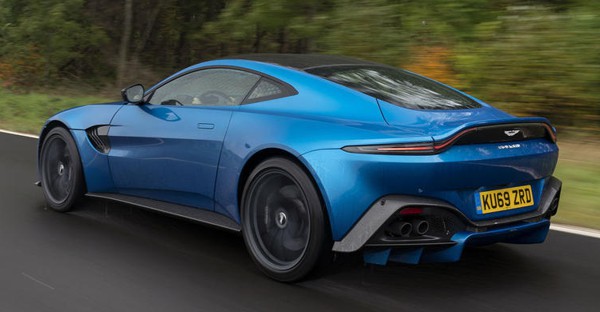
|
|
Handling
is sharper and more agile, but the manual gearbox disappoints.
|
|
Judging from the gearbox alone, the answer is negative. As before, this
7-speed manual employs a dog-leg first gear, so the shift pattern is
all changed from the conventional norm. For a keen driver, it is not
easy to adapt his basic instinct to the new way of work. Moreover, the
shift quality leaves something to be desired. The gate is tight and the
shift is clunky. The big and cheap gear knob feels uncomfortable in
hand. The only thing worth praising is the availability of automatic
throttle blipping, so it will match rev in downshift without requiring
the driver to master heel-and-toe technique. The manual gearbox engages
its driver more, but not necessarily in a positive way.
Changes to the chassis make the AMR edgier on the limit. The mechanical
differential induces a little understeer when approaching corners,
which is welcomed, but when it starts locking, it is more violent than
the active differential, resulting in a more dramatic oversteer. On a
dry road, the car is certainly more playful, more fun to devoted
drivers. Its lighter weight and retuned dampers contribute to more
agility and composure without downgrading the ride too much. On wet or
less perfect roads, it is more nervous and difficult to drive. This is
a car for hardcore drivers.
However, hardcore drivers will find the Porsche GT3 and GT4 much more
engaging, precise and confidence inspiring. The AMR is neither sharp
nor forgiving enough to threaten Porsches. That’s why it has to be
rare. Only 200 cars will be built. Afterwards, you may opt for the
Graziano gearbox on the regular Vantage, although I doubt many buyers
would. |
Verdict:    |
Published
on 13
Sep 2021
|
All rights reserved.
|
|
Vantage F1 Edition
|
|
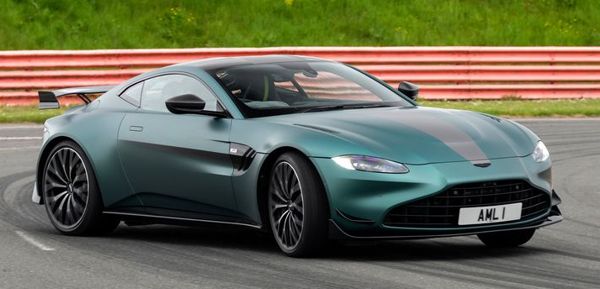
|
|
Finally,
the potential of Vantage is unlocked.
|
|
Aston Martin has undergone
some big changes lately. Lawrence Stroll & Co. took over control of
the British car maker. Tobias Moers was head-hunted from AMG to lead
its turnaround. The inhouse-built V6 was cancelled, but Moers secured
supply of the most sophisticated AMG powertrains. Meanwhile, Aston
Martin re-entered Formula One racing by rebranding the former Racing
Point team, which rebranded Force India, which rebranded Spyker, which
rebranded Midland, which rebranded Jordan that was founded by Eddie
Jordan 30 years ago – remember Michael Schumacher’s debut race in Spa
1991? While the F1 team is not real Aston Martin effort, the car built
to celebrate its re-entry into F1 racing is: Vantage F1 Edition.
Strangely, the F1 Edition is not a limited edition. It is not a
million-dollar special either. Instead, it is what the standard Vantage
should have been, better than that car in every way yet costs only
£20,000 more at £142,000. Undoubtedly, most buyers will
turn to this car, until the next mid-life update happens in a couple of
year’s time.
When Moers arrived Gaydon, he identified the weak point of the Vantage
is lack of speed. However, a deal with AMG to supply the more powerful
versions of its V8 is yet to be agreed, so Aston could only tweak the
ECU and get another 25 horsepower while leaving torque unchanged.
Likewise, the Graziano 8-speed dual-clutch gearbox of Valhalla was not
in place yet, so they had to remap the ZF 8-speed automatic transaxle
to find extra speed. This is partly achieved by removing the momentary
power cut-off between gears, previously introduced deliberately to make
the gearshift feel more dramatic. In this way, the gearshift becomes
not only quicker but also smoother.
But the powertrain improvement accounts for little performance gain.
Moers gave his chassis engineers a hard target: cut 15 seconds from the
Vantage’s Nurburgring lap time of 7:45, which is about as slow as a
Honda Civic Type R. And that should not be achieved by using track
tires like Michelin Cup 2.
The first thing they modified was aero: 200kg more downforce is found
at top speed by those extended front splitter, winglets and rear wing,
hence the decision to name it “F1 Edition”. The front and rear now
generate 60kg and 150kg downforce, respectively.
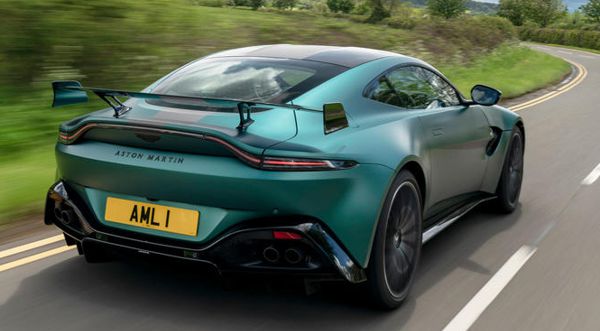
|
|
Faster,
more precise and better looking, the F1 is better than the existing car
in every way. |
|
Then they beefed up the chassis with a thicker shear panel under the
engine, stiffened the bushings at steering column and front control
arms, increased negative camber of the front wheels by half a degree,
increased rear spring rate by 10 percent, front rebound damping rate by
18 percent and rear compression damping rate by 20 percent. Besides, a
lateral damper is added to tighten the motion of the transaxle,
something Moers learned from the development of AMG SLS and GT.
Finally, the car is fitted with larger, 21-inch wheels and lower
profile Pirelli P Zero tires, whose slightly larger contact patch
should add a little bit more traction and grip.
The best thing to me is the return of a proper front grille, replacing
the vacuum cleaner-style nozzle of the existing Vantage.
On the Road
Yes, the revised engine feels a bit more energetic from 5000 rpm to the
7000 rpm cut-out, its exhaust note is angrier, the gearshift feels as
responsive as a torque-converter automatic can get, but the powertrain
is not the amazing point of the car, unlike a Ferrari or Porsche GT3.
Instead, it is the chassis. The F1 has a tighter body control than the
regular Vantage, especially at faster pace. The steering gets more
weight as well as precision without hurting communication. The rear
axle is more tied down, making the car more stable in corner. Whereas
the old Vantage is prone to wayward, the new one is more planted, less
likely to slide and spin. Power slide is still easily accessible on a
track, but the transition to oversteer is more progressive and
controllable. Switch ESC off will reveal an inherently balanced
chassis, but now it is less likely to bite you.
While the suspension does feel stiffer, in the softest mode it still
covers a poor British country road with ease, something cannot be said
to the new Porsche GT3 or an AMG GT. At faster paces, the stiffer
damping actually improves the ride a little bit as the car feels more
composed. The F1 Edition finally unlocks the potential of the Vantage.
|
Verdict:     |
Published
on 31
Oct 2022
|
All rights reserved.
|
|
V12 Vantage
|
|
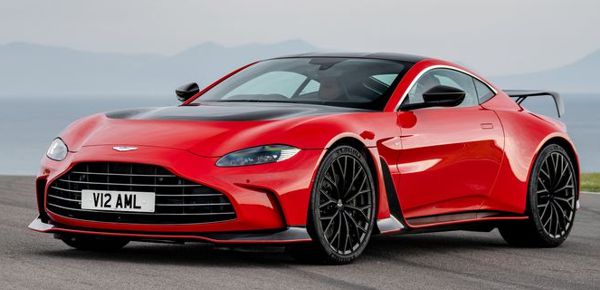
|
|
V12
Vantage becomes a limited edition, but its talents are also limited.
|
|
It is a sorrow to hear the
new V12 Vantage signals the end of the line that started in 2009. Back
then, the V12 version of Vantage answered the question raised against
the standard car: insufficient power. It packed a big V12 into a
relatively compact and lightweight 2-seater body, lifted performance to
190 mph and 0-60 in 4.1 seconds. The revision in 2013 (Vantage S)
improved further to 205 mph and 3.7 seconds, then bowed out on a high
with the limited edition Vantage GT12, a striped out, track-oriented
version that was good for 600 hp and 3.5 seconds 0-60,
accompanied with a price tag of £250,000.
In many ways, the final V12 Vantage is very much like the Vantage GT12.
It is also a limited edition, although the batch increases from 100 to
333 cars (and sold out before public debut). It is priced at
£265,000, slightly cheaper than the old
car with inflation considered, but still double the price of a regular
V8 Vantage. However, the new car is not as extreme as the GT12, no
matter in weight saving or aerodynamics, therefore Aston opts to retain
the name V12 Vantage.
This is a good-looking car, unquestionably. Thanks to wider fenders, a
larger grille, extra vents opened fore and aft of the front wheels,
deeper skirts and front splitter as well as a larger fixed rear wing,
it looks more aggressive, too.
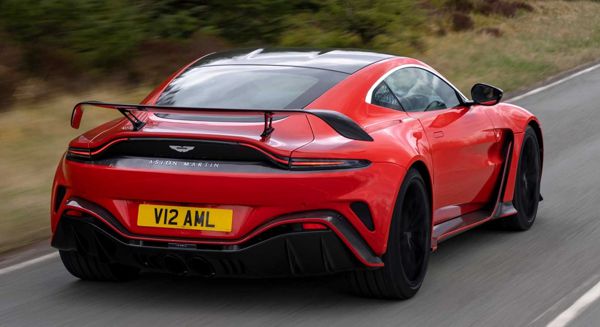
|
|
Lots
of carbon-fiber is used throughout but still it weighs 1795 kg. |
|
Open the bonnet, under the stiffening bracket the engine bay is filled
fully by a 5.2-liter V12 completed with twin-turbochargers. It comes
from the DBS Superleggera, but because there is no space for the
latter’s ZF 8HP95 transmission, it has to retain the standard car’s
8HP75. That’s why the V12 motor has to be detuned, dropping its peak
torque from 664 lbft to 555 lbft, while power is reduced by 25 hp to
700 hp. Still, no one can call 700 horsepower tamed.
Nevertheless, the car gains considerable weight, too. The twin-turbo
V12 accompanied with a torque-converter automatic transmission must be
a lot heavier than the last atmospheric unit and manual / automated
manual gearbox. It lifts the kerb weight from the old car’s 1665 kg to
an alarming 1795 kg. And that’s already reduced by using a lot of
lightweight materials, such as carbon-fiber bonnet, front fenders,
front bumper and side sills, composite rear bumper and rear deck,
standard ceramic brakes (which save 23kg), carbon-shell bucket seats
(7kg saved), thin-wall stainless steel exhaust (another 7kg slashed)
and lightweight battery. Curiously, the car is even heavier than the
DBS Superleggera, which is difficult to understand.
Weight is one problem, how weight distributed is another. While the old
car employed rear-mounted transaxle to help balancing the engine, the
new car has its ZF automatic installed just behind the
engine, worsening weight distribution from 51:49 to 53:47 (V8 Vantage
is 50:50). This means less traction afforded by the rear tires.
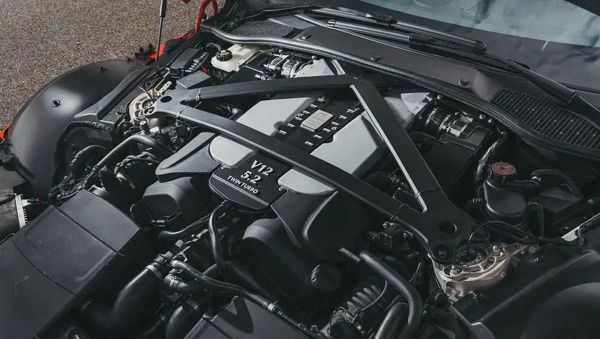
|
|
Despite
700 horsepower, the use of old gearbox means torque has to be reduced
to 555 lbft. No wonder mid-range doesn't feel explosive. |
|
No wonder the performance claim is underwhelming. Its top speed is 200
mph, merely 5 mph higher than the V8 Vantage. Likewise, 0-60 mph time
of 3.4 seconds is just a tenth quicker than the V8 model, and
trails the DBS Superleggera by a tenth. Even the aggressive aerodynamic
kits don't perform as good as they look. They produce 204 kg of
downforce at top speed - yes, at 200 mph. For reference, Porsche 911
GT3 generates 385 kg at 124 mph.
As for chassis, extra shear panels
front and rear, a rear suspension tower bar and fuel tank bracing
improve its torsional rigidity by 8 percent. To cope with the extra
weight, suspension springs have been stiffened by 50% up front and 40%
at the rear. Suspension bushings and front anti-roll bar are slightly
stiffer, but rear anti-roll bar is softened by 41 percent to promote
rear-end grip, taming the tendency of oversteer due to high power and
short wheelbase. The wheels are kept at 21-inch, but each tire gets 20
mm wider. The extended fenders house not only wider tires but also 40
mm wider tracks. On the downside, for unknown reasons, the active
differential of V8 model has been replaced with a mechanical LSD. It
has too many compromises.
On the road, you will find the V12 Vantage has it ride quality damaged
by the chassis modifications. It is stiff in comfort mode, very stiff
in Sport mode and Oh-my-God-stiff in Track mode. Somehow, it fails to
repeat the outstanding handling and ride balance of its predecessor,
seems like the departure of engineering chief Ian Minards and chassis
tuning expert Matt Becker finally come into effect. In addition to the
loud tire roar and the very uncomfortable carbon-fiber bucket seats,
the new car has lost the V12 Vantage’s uncanny ability as a
long-distance GT.
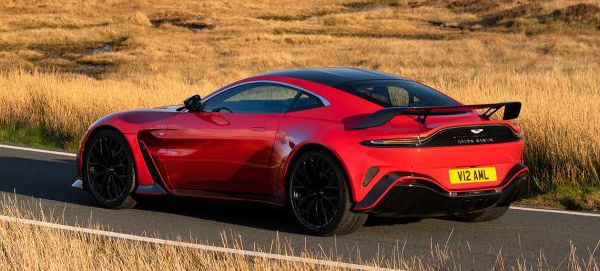 |
|
Absolutely
beautiful, but driving excitement fails to match. |
|
Is it a better sports car or track car then? While it is faster,
unquestionably, not all developments point to the right direction.
The turbocharged V12 is a bit disappointing. For a car targeting at
super sports cars, its sound is
neither loud nor angry enough to excite. Its mid-range punch is also
not as strong as what you would expect for a 700-horsepower machine. In
fact, no more special than the V8 Vantage F1 edition. Likewise, the ZF
automatic is no match for a proper DCT for shift speed and precision.
Sometimes reluctant to downshift, too.
On a track, the stiff suspension is no longer an issue, and it keeps
the car stable in corner, with minimal pitch and roll. Though riding on
road tires only – it uses Michelin Pilot Sport 4S rather than Cup 2 –
roadholding is very good. The brakes have power and feel. The steering
is not so good, heavy and lacks feel, but at least accurate and get the
job done. Despite the front-biased weight distribution, the V12 Vantage
offers remarkable front-end grip, as evident in its responsive turn-in.
It can be pushed very hard and still stick to its line. In tighter
corners, it could feel a bit nose-heavy, easier to run wide or spin its
inside rear wheel if you feed in too much power too early – not unlike
a Corvette Z06 before switching to mid-engined. However, in faster
bends it feels absolutely pin-sharp. At the limit, it will oversteer
progressively, but it is not as easy to hold the slide like the old V12
Vantage, as it has a strong tendency to return to neutral. For sure it
is much faster on track, but the lack of steering connection and
delicate balance on throttle make the new car duller and less engaging
to drive hard.
So what is it? Not quite a rival to the mid-engined super sports cars
like Ferrari F8 or McLaren. Not track-capable enough to threaten 911
GT3 and GT3 RS. Nor it is as streetable as great GTs like Ferrari
Superfast or Aston’s own DBS. While the old V12 Vantage was praised for
bridging the best of both worlds, the new car can satisfy neither’s
requirements. No wonder it is destined to be shortlived.
|
Verdict:    |
Published
on 26
Jul 2024
|
All rights reserved.
|
|
Vantage 2024 update
|
|
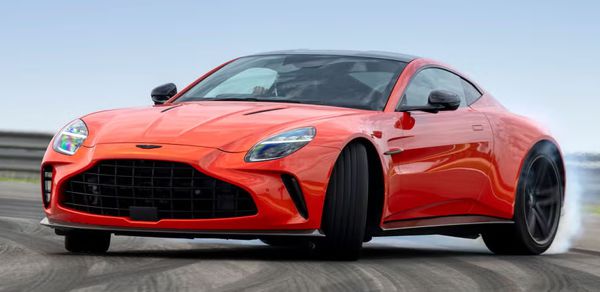
|
|
Unsuccessful
Vantage is given another lease of life.
|
|
The outgoing Vantage was
supposed to be Aston’s equivalent of Porsche 911 Carrera. Somehow, few
customers prefer it to the iconic Porsche. In the latest update, Aston
has changed its strategy a little. Although the car remains to be the
entry-level Aston Martin, it is no longer that affordable. Price has
risen from £121,000 to £165,000, accompanied with a big
boost of power that outshines even the most potent 911 Turbo S. The
character of the car has also changed a little, being more sports car
and less GT.
From outside you can already tell its sportier pretension: a much
larger front grille is employed to feed an additional radiator, 2
extra water coolers and a larger oil cooler. This is necessary because
the new car gets a far more powerful version of AMG twin-turbo V8. The
last Vantage was handicapped by an unfavourable agreement with
Mercedes-AMG that prevented it from using the most potent versions of
AMG V8. Now that agreement is obviously relaxed such that the latest
DB12 and DBX can offer 680 and 707 horsepower, respectively. The
Vantage is a smaller and cheaper car, of course, but Aston still gives
it 665 horsepower and 590 pound-foot of torque, which is a massive 130
hp and 85 lbft up from the F1 Edition. The extra power is achieved with
larger turbos and the aforementioned enhanced cooling. To avoid
overheating the cylinder heads, compression ratio is lowered from
10.5:1 to 8.6:1.
The Aston continues to use ZF 8-speed automatic transmission instead of
Mercedes’ MCT gearbox, and it is mounted at the rear axle to achieve
50:50 balance, something not even the current AMG GT can claim.
Transmission ratios are unaltered, but the final drive ratio is 5
percent shorter, boosting acceleration further. That’s why top speed is
lifted only slightly from 195 to 202 mph. Aston said 0-60 mph sprint
takes 3.4 seconds, merely a tenth less than before, curiously.
Rear-wheel traction might be a limiting factor, but this number is
probably conservative.
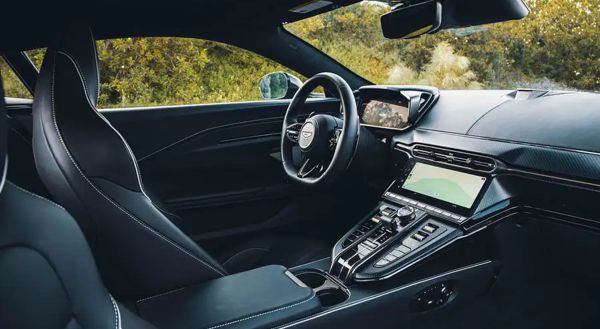
|
|
Massive
power boost is accompanied with massive improvement of cabin tech. |
|
To support the enhanced power, the chassis is reinforced in various
locations, especially around the front and rear suspensions. A
relocated front cross member and stiffer engine cradle stiffen the
structure up front, while a stronger rear tower bar and underbody tray
do the same to the rear. In order to deliver stronger sense of
connection, the electric power steering is now rigidly mounted on
subframe without bushings. Wider fenders cover wider tracks and beefed
up rubbers – 275/35ZR21 up front, 325/30ZR21 at the rear, and the
bespoke compound of those Michelin Pilot Sport 5 S should generate
significantly more grip. New Bilstein DTX adaptive dampers, also used
in Porsche 992, are said to deliver a broader range of adjustment and
faster response. The steel brakes are larger, too, while ceramic brakes
continue to be listed as option.
Inside, the Vantage takes the new electronic instrument and touchscreen
infotainment system from the DB12. Its software user interface is still
not the most intuitive, but nonetheless a massive improvement from the
old Mercedes-sourced stuff. Moreover, the Panamera-style slopping
center console has a lot of buttons and knobs, so that you won’t
confuse it with any cheap Chinese EVs. The last Vantage was not
renowned for interior build quality, but this one can feel proud.
On the road, the new engine feels more turbocharged. Bigger turbos
means more lag at lower revs, but the stronger build-up of mid-to-upper
range muscle makes a bigger impression, accompanied with an addictive
symphony of induction and exhaust noise that bests any AMG V8s ever
used in Aston. The power delivery is by no means the all-or-nothing
response of old-school turbocharged motors, as the transition is smooth
and predictable, but it certainly adds to the character and sense of
occasion of the powertrain.
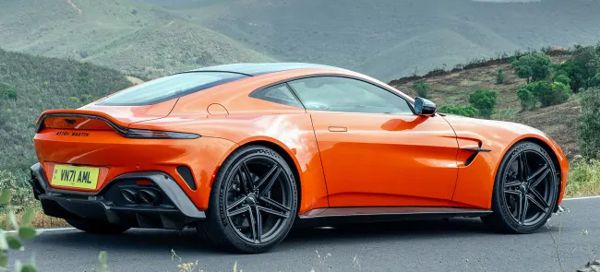 |
|
This
is a car you can trust and push on road or track. |
|
With 590 lbft of torque for disposal from just 2000 rpm and a shorter
final drive ratio, the AMG V8 is easy to run into its rev limiter. When
the auto box is left to its own device in normal mode, it tends to
upshift early. Conversely, in Sport+ mode the box is too eager to
downshift a ratio under throttle, so you learn to drive in manual mode.
Surprisingly, the engine rarely feels overwhelming. It is a testimony
that Aston has done a great job to upgrade the chassis. There is
remarkable front-end grip to keep the nose pointing to the right
direction. This is a wide car, but it shrinks around you on the road as
its motion is precisely controlled, and you feel more connected to the
road through the steering. The rear axle, benefited from slightly
softer springs and beefier tires, offers more traction, which is
important for such a powerful FR machine. Moreover, there is a
sophisticated 9-stage traction control and the latest Bosch stability
control working with active differential to tame wheel spin and
oversteer, allowing power-slide on a wider track. The hardware might
not be much different from before, but the software and tuning make a
decisive difference. This is a car you can trust and push on road or
track. It doesn’t feel as light or as agile as Porsche or any
mid-engined rivals, but definitely better to drive than any recent
Astons.
On the downside, the transformation comes at the expense of some ride
comfort. Older Astons like those naturally aspirated V12 Vantages were
renowned for supple ride thus worked superbly as long-distance GTs. The
new Vantage’s suspension is firmer and less absorbent, and the gearing
leads to a more urgent character. In other words, it is more sports car
than GT. That might be good to distant itself from DB12, but whether
that can lure buyers from Porsche remains to be seen.
|
Verdict:     |
Published
on 27
Jul 2024
|
All rights reserved.
|
|
Valour
|
|
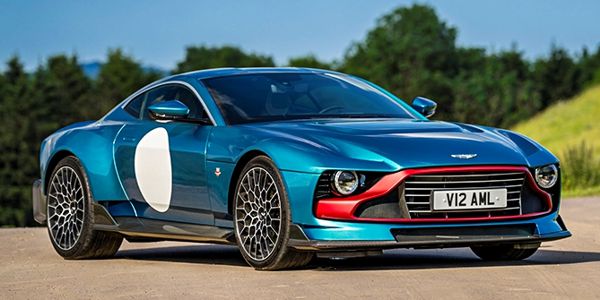
|
|
Aston's
latest collector special brings back the joy of manual gearshift.
|
|
150 cars, £1.5
million apiece, derived from V12 Vantage that costs less than a fifth
of its price, doesn’t it sound crazy?
Custom-built cars have been popular to rich people lately, and that
might save the fortune of Aston Martin. The Valour must be a
profit-maker for Gaydon, but certainly it won’t be the last. A
track-oriented version called Valiant is just around the corner, and it
will command £2 million…
The Valour is mechanically very similar to the V12 Vantage which has
already gone out of production after just 333 cars. It uses the same
5.2-liter twin-turbo V12, but tuned to deliver slightly higher output
at 715 hp, while torque remains unchanged at 555 lbft. The latter is
actually limited by its 6-speed manual gearbox, whose combination with
a V12 engine is unique nowadays. Well, Pagani and Gordon Murray will
sell you manual V12, but in the world of front-engined GT, the Valour
is unique. Ferrari opts for twin-clutch transmission,
while other Astons rely on torque-converter automatic.
Don’t underestimate the demand for manual gearboxes. Ferrari said it
abandoned them because too few customers chose it instead of its
paddle-shifters, but at the very exclusive, custom-made market segment,
the situation is on the contrary. People sees purchasing million-dollar
cars as investment. And you know, because of their rarity these days,
manual cars can always command higher prices in collector’s market.
Moreover, just as Gordon Murray would tell you, the joy of making
gearshift yourself is unparalleled, shouldn’t be traded for a couple of
tenths of a second.
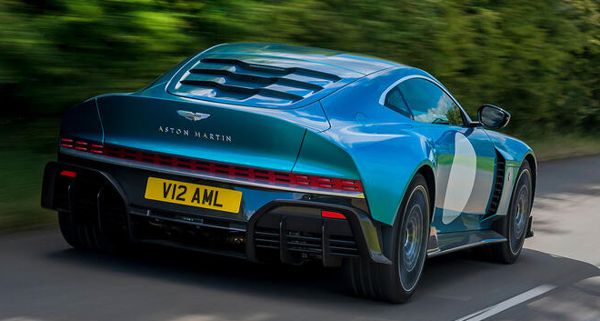
|
|
While
nothing sets new standards, everything works in harmony to deliver a
big GT-car feel. |
|
The 6-speed manual box on Valour is made by Graziano. It comes from the
last naturally aspirated V12 Vantage. Surprisingly, its gearshift is
pretty slick and precise, well matched with a light clutch and throttle
pedal. The V12 motor is a little quiet, but sound quality-wise a V12
never disappoints. The powertrain combo offers a traditional, big
GT-car feel.
The gearbox is a transaxle, sitting at the rear axle to achieve perfect
balance. It hooks up to an old-school mechanical LSD instead of the
E-diff on the latest Aston line-up, but its behaviour is progressive
and predictable. Soft suspension setting, again like the previous
generation V12 Vantage, delivers superb ride comfort and good traction
simultaneously. Handling is not as sharp as the latest cars, of course,
but the steering is accurate. There is a bit more roll in corner but by
no means alarming. Instead, it lets you know how hard you are
cornering. The nose feels a bit heavy in a hurry, suggesting some safe
understeer approaching corner. You tend to drive the car in old-school
way, slow in, fast out, let the tremendous torque do the thing.
A collector’s car should have a unique look, and this car gets it.
While the center section that covers passenger cell is obviously
Vantage, the front and rear end are very different. The rear design is
especially remarkable, dominated by kamm tail, full-width light bar and
large diffusers. The rear window is replaced with a classic louvered
panel just to add some visual appeal. The design blends classical
elements and modern styling in harmony, no wonder all 150 cars have
been
sold out before announcement.
The only real weakness of the car is its interior, which is carried
over from the pre-update Vantage. Its funky design is a stark contrast
to the rest of the car, while the Mercedes-sourced infotainment system
–
still does without touchscreen – is a generation or two behind the
current setup in other Astons. Why not simply reuse the
metallic gauges and center console of older Astons?
|
Verdict:     |
|